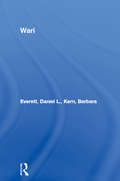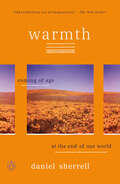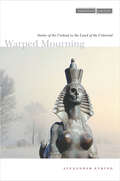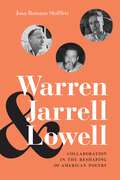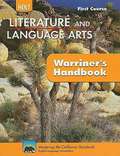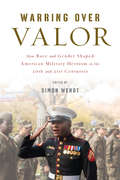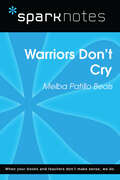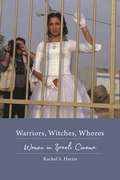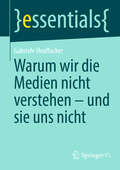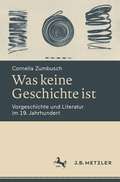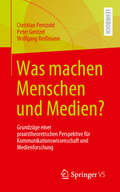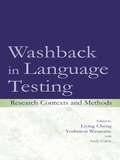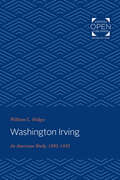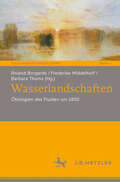- Table View
- List View
Wari (Descriptive Grammars)
by Daniel L. Everett Barbara KernThis is the first major study of any Chapakuran language and makes an important contribution to linguistic theory. This study is especially timely as the Chapakuran languages of Western Brazil and Eastern Bolivia are endangered, and less than 2,000 known speakers of Wari and its related dialects are left in existence.
Warmth: Coming of Age at the End of Our World
by Daniel SherrellFrom a millennial climate activist, an exploration of how young people live in the shadow of catastrophe&“Strikingly perceptive.&” —Jenny Offill, author of Weather &“Beautifully rendered and bracingly honest.&” —Jenny Odell, author of How to Do NothingWarmth is a new kind of book about climate change: not what it is or how we solve it, but how it feels to imagine a future--and a family--under its weight. In a fiercely personal account written from inside the climate movement, Sherrell lays bare how the crisis is transforming our relationships to time, to hope, and to each other. At once a memoir, a love letter, and an electric work of criticism, Warmth goes to the heart of the defining question of our time: how do we go on in a world that may not?
Warped Mourning: Stories of the Undead in the Land of the Unburied (Cultural Memory in the Present)
by Alexander EtkindAfter Stalin's death in 1953, the Soviet Union dismantled the enormous system of terror and torture that he had created. But there has never been any Russian ban on former party functionaries, nor any external authority to dispense justice. Memorials to the Soviet victims are inadequate, and their families have received no significant compensation. This book's premise is that late Soviet and post-Soviet culture, haunted by its past, has produced a unique set of memorial practices. More than twenty years after the collapse of the Soviet Union, Russia remains "the land of the unburied": the events of the mid-twentieth century are still very much alive, and still contentious. Alexander Etkind shows how post-Soviet Russia has turned the painful process of mastering the past into an important part of its political present.
Warren, Jarrell, and Lowell: Collaboration in the Reshaping of American Poetry
by Joan Romano ShifflettRobert Penn Warren, Randall Jarrell, and Robert Lowell maintained lifelong, well-documented friendships with one another, often discussing each other’s work in private correspondence and published reviews. Joan Romano Shifflett’s Warren, Jarrell, and Lowell: Collaboration in the Reshaping of American Poetry traces the artistic and personal connections between the three writers. Her study uncovers the significance of their parallel literary development and reevaluates dominant views of how American poetry evolved during the mid-twentieth century. Familiar accounts of literary history, most prominently the celebration of Lowell’s Life Studies as a revolutionary breakthrough into confessional poetry, have obscured the significance of the deep connections that Lowell shared with Warren and Jarrell. They all became quite close in the 1930s, with the content and style of their early poetry revealing the impact of their mentors John Crowe Ransom and Allen Tate, whose aesthetics the three would ultimately modify and transform. The three poets achieved professional maturity and success in the 1940s, during which time they relied on one another’s honest critiques as they experimented with changes in subject matter and modes of expression. Shifflett shows that their works of the late 1940s were heavily influenced by Robert Frost. This period found Warren, Jarrell, and Lowell infusing ostensibly simple verse with multifaceted layers of meaning, capturing the language of speech in diction and rhythm, and striving to raise human experience to a universal level. During the 1950s, the three poets became public figures, producing major works that addressed the nation’s postwar need to reconnect with humanity. Warren, Jarrell, and Lowell continued to respond in interlocking ways throughout the 1960s, with each writer using innovative stylistic techniques to create a colloquy with readers that directed attention away from superficial matters and toward the important work of self-reflection. Drawing from biographical materials and correspondence, along with detailed readings of many poems, Warren, Jarrell, and Lowell offers a compelling new perspective on the shaping of twentieth-century American poetry.
Warriner's English Grammar and Composition (Liberty Edition: Fourth Course)
by William WarrinerThis textbook is designed to help you improve your ability to use English. It will show you how the English sentence works, how words are combined in sentences, and how the parts of sentences may best be arranged for clear communication. You will learn the difference between sentences which are strong and clear and smooth, and sentences which are weak and confusing and awkward.
Warriner's English Grammar and Composition Liberty Edition, First Course
by John E. WarrinerThis textbook will be a valuable aid in your study of English. In it you will find an explanation of how the language works, which is something you need to understand if you are to learn to express yourself correctly and effectively. You will find exercises and writing assignments that you need for practice. The book will teach you the difference between an effective sentence and an ineffective one, between strong writing and weak writing. You will learn to express yourself in correct, clear and interesting English.
Warring over Valor: How Race and Gender Shaped American Military Heroism in the Twentieth and Twenty-First Centuries (War Culture)
by Steve Estes Ellen D. Wu Simon Hall Matthias Voigt Simon Wendt George Lewis Amy Lucker Sarah Makeschin Sonja John Carrie AndersenBy focusing on how the idea of heroism on the battlefield helped construct, perpetuate, and challenge racial and gender hierarchies in the United States between World War I and the present, Warring over Valor provides fresh perspectives on the history of American military heroism. The book offers two major insights into the history of military heroism. First, it reveals a precarious ambiguity in the efforts of minorities such as African Americans, Asian Americans, Native Americans, women, and gay men to be recognized as heroic soldiers. Paradoxically, America’s heroism discourse allowed them to press their case for full membership in the nation, but doing so simultaneously validated the dichotomous interpretations of race and gender they repudiated. The ambiguous role of marginalized groups in war-related hero-making processes also testifies to this volume’s second general insight: the durability and tenacity of the masculine warrior hero in U.S. society and culture. Warring over Valor bridges a gap in the historiography of heroism and military affairs.
Warrior-Writers of World War II (Routledge Studies in Twentieth-Century Literature)
by Lee CongdonWarrior-Writers of World War II delivers a thorough study of Americans who saw combat in World War II, survived, and returned home to become famous writers. It considers the works of 16 important authors, among them J. D. Salinger, John Ciardi, and James Jones, exploring these men’s war experiences and their reflection in their writings. This includes what they learned about themselves and, even more important, what they can teach the rest of us about war and peace, good and evil, hatred and pity, honor and dishonor, fate and chance—and about the sustaining power of comradeship.This critical overview will be useful to general readers and academics seeking to deepen their understanding of the impact World War II has had on twentieth-century literature.
Warriors Don't Cry (SparkNotes Literature Guide Series)
by SparkNotesWarriors Don't Cry (SparkNotes Literature Guide) by Melba Patillo Beals Making the reading experience fun! Created by Harvard students for students everywhere, SparkNotes is a new breed of study guide: smarter, better, faster. Geared to what today's students need to know, SparkNotes provides: *Chapter-by-chapter analysis *Explanations of key themes, motifs, and symbols *A review quiz and essay topicsLively and accessible, these guides are perfect for late-night studying and writing papers
Warriors, Witches, Whores: Women in Israeli Cinema
by Rachel S. HarrisWarriors, Witches, Whores: Women in Israeli Cinema is a feminist study of Israel’s film industry and the changes that have occurred since the 1990s. Working in feminist film theory, the book adopts a cultural studies approach, considering the creation of a female-centered and thematically feminist film culture in light of structural and ideological shifts in Israeli society. Author Rachel S. Harris situates these changes in dialogue with the cinematic history that preceded them and the ongoing social inequalities that perpetuate women’s marginalization within Israeli society. While no one can deny Israel’s Western women’s advancements, feminist filmmakers frequently turn to Israel’s less impressive underbelly as sources for their inspiration. Their films have focused on sexism, the negative impact of militarism on women’s experience, rape culture, prostitution, and sexual abuse. These films also tend to include subjects from society’s geographical periphery and social margins, such as female foreign workers, women, and refugees. Warriors, Witches, Whoresis divided into three major sections and each considers a different form of feminist engagement. The first part explores films that situate women in traditionally male spheres of militarism, considering the impact of interjecting women within hegemonic spaces or reconceptualizing them in feminist ways. The second part recovers the narratives of women’s experience that were previously marginalized or silenced, thereby creating a distinct female space that offers new kinds of storytelling and cinematic aesthetics that reflect feminist expressions of identity. The third part offers examples of feminist activism that reach beyond the boundaries of the film to comment on social issues, particularly those which affect women. This section demonstrates how feminists use film (and work within the film industry) in order to women’s position in society. While there are thematic overlaps between the chapters, each section marks structural differences in the modes of feminist response. Warriors, Witches, Whores considers the ways social and political power have impacted the representation of women and looks to how feminist filmmakers have fought against these inequities behind the camera, in the stories they tell, and in the ways women are depicted on screen. Students and scholars of film, gender, or cultural studies will appreciate this approachable monograph.
Wars within a War: Controversy and Conflict over the American Civil War
by Gary W. Gallagher Joan WaughComprised of essays from 12 leading scholars, this volume extends the discussion of Civil War controversies far past the death of the Confederacy in the spring of 1865. Contributors address, among other topics, Walt Whitman's poetry, the handling of the Union and Confederate dead, the treatment of disabled and destitute northern veterans, Ulysses S. Grant's imposing tomb, and Hollywood's long relationship with the Lost Cause narrative. The contributors are William Blair, Stephen Cushman, Drew Gilpin Faust, Gary W. Gallagher, J. Matthew Gallman, Joseph T. Glatthaar, Harold Holzer, James Marten, Stephanie McCurry, James M. McPherson, Carol Reardon, and Joan Waugh.
Warum wir die Medien nicht verstehen - und sie uns nicht (essentials)
by Gabriele HooffackerWarum berichten Medien über manche Themen und über manche nicht? Warum missfallen uns manche Nachrichten und erst recht manche Kommentare? Was führt zu Verzerrungen der Wahrnehmung beim Publikum - und auch bei Journalistinnen und Journalisten? Der Band bietet Wissenswertes aus Redaktionen und Journalismus-Ausbildung und gibt Einblicke in die Wahrnehmungspsychologie, etwa den Hostile Media Effekt oder den Third-Person- Effect. Ziel ist, fundierte Medienkritik zu ermöglichen.
Was keine Geschichte ist: Vorgeschichte und Literatur im 19. Jahrhundert
by Cornelia ZumbuschUnter Vorgeschichte versteht man gewöhnlich die Geschichte der Menschen vor dem Einsatz schriftlicher Zeugnisse. In Bezug auf literarische Erzählungen hingegen meint Vorgeschichte das, was zwar vor dem Anfang der Geschichte geschehen ist, aber erst später erzählt wird. Ein zentraler Text für die Erforschung der Vorgeschichte sowohl in der prähistorischen Archäologie als auch in der Narratologie ist die homerische Odyssee. Am Leitfaden der Homer-Rezeption geht die Studie deshalb den Formen der Vorgeschichte im 19. Jahrhundert nach. Wie wird Vorgeschichte zum Gegenstand der Wissenschaften? Warum erzählen Romane von Goethe, Stifter und Fontane nicht nur Geschichten, sondern auch in diese eingelagerte Vorgeschichten? Und in welchem Zusammenhang steht diese Erzählform mit dem auffälligen Interesse der Literatur an Altertümern und prähistorischen Relikten?
Was machen Menschen und Medien?: Grundzüge einer praxistheoretischen Perspektive für Kommunikationswissenschaft und Medienforschung
by Wolfgang Reißmann Christian Pentzold Peter GentzelDie Rede von Praktiken ist in der Kommunikations- und Medienwissenschaft weit verbreitet. Eine systematische Diskussion des Potenzials praxistheoretischer Denk- und Forschungsansätze steht dagegen noch aus. Dieses Buch ist eine Einladung zur tieferen Beschäftigung mit Medienpraktiken und wirbt für eine entsprechende Neuorientierung von Kommunikationsforschung und Medienanalyse. Dazu wird der Status quo praxistheoretischer Ansätze in der Kommunikations- und Medienwissenschaft kompakt vorgestellt. Interessierte bekommen einen Einstieg und Expert:innen werden Anschlussmöglichkeiten angeboten. Es geht sowohl um Grundprinzipien praxistheoretischen Denkens als auch um die sich daraus ergebenden Haltungen sowie um Zugänge für praktische Untersuchungen. Im Zentrum stehen aktuelle Herausforderungen und die Möglichkeiten, Praktiken in Digitalmedien und vernetzten Medienumgebungen zu analysieren.
Washback in Language Testing: Research Contexts and Methods
by Andy Curtis Liying Cheng Yoshinori WatanabeWashback refers to the influence of language testing on teaching and learning. This volume, at the important intersection of language testing and teaching practices, presents theoretical, methodological, and practical guidance for current and future washback studies. In the field of language testing, researchers' major interest has traditionally been focused on issues and solving problems inherent in tests in order to increase their reliability and validity. However, the washback effect goes well beyond the test itself to include factors, such as curriculum, teacher and learner behaviors inside and outside the classroom, their perceptions of the test, and how test scores are used. Only recently have researchers started to empirically investigate the phenomenon of washback. This volume of such research serves two essential purposes by:*providing an overview of the complexity of washback and the various contextual factors entangled within testing, teaching, and learning; and *presenting empirical studies from around the world that offer insights into the effects of washback in specific educational contexts and models of research on which future studies can be based. The extensive use of test scores for various educational and social purposes in society nowadays makes the washback effect a high-interest phenomenon in the day-to-day educational activities of teachers, researchers, program coordinators/directors, policymakers, and others in the field of education. Washback in Language Testing: Research Contexts and Methods is a valuable resource for those who are interested in the application of findings to actual teaching and learning situations or conduct washback research in their own contexts, including educational and psychological testing experts, as well as alternative assessment people in all fields, and for policy- and decision-makers in educational and testing organizations.
Washington Irving: An American Study, 1802-1832 (Goucher Colloquium)
by William L. HedgesOriginally published in 1965. Despite his prolificacy, Washington Irving remained an underexamined figure among literary scholars at the time William L. Hedges published his definitive study of the author in 1965. Most contemporary scholars believed that Irving's central contribution to the American literary tradition was that his work was "polished" and "suave." These scholars maintained that Irving's aristocratic sensibilities defined the stylistic choices of his literary works. To assume this, Hedges contends, is to "both let the man and the work slip beyond one's grasp." Hedges demonstrates that much of Irving's work can be understood in the context of his conflict between federalist and conservative politics. Irving, in other words, found himself incapable of committing to a coherent set of beliefs or attitudes, and this cultural uneasiness manifested itself in his early work. Washington Irving: An American Study, 1802-1832 tries to correct some of the misapprehension about Irving's place in nineteenth-century American literature.
Wasserlandschaften: Ökologien des Fluiden um 1800 (Neue Romantikforschung #9)
by Roland Borgards Frederike Middelhoff Barbara ThumsWasser erhält Ende des 18. und im Verlauf des 19. Jahrhunderts lokal und global betrachtet den Status eines ‚Superelements‘: Es wird ökonomisch (Dampfmaschine), naturwissenschaftlich (Neptunismus), ästhetisch und kunsttheoretisch (von der Landschaftsmalerei und -dichtung bis hin zur Gartenkunst) zum Motor, Medium und Modell für die Dynamiken der Moderne. In diesem Kontext werden Wasserlandschaften insbesondere in den europäischen Romantiken zu privilegierten (Denk-)Räumen und Umwelten, um Wechselwirkungen zwischen unterschiedlichen organischen und anorganischen Akteuren zu beobachten und deren Dynamiken ästhetisch in Szene zu setzen. Durch das stets volatile Prisma der Wasserlandschaften kommen auf diese Weise ökologische Beziehungen auch in ihren lokalen Besonderheiten in den Blick. Der Band erkundet den Stellenwert und die Materialität des Wassers um 1800 anhand konkreter Beispiele wasserlandschaftlicher Formationen in Literatur, Malerei und Musik. Philosophische und wissensgeschichtlich orientierte Perspektiven werden dabei ebenso berücksichtigt wie neuere Ansätze der ökokritischen Forschung und der Blue Humanities. Ausgelotet wird in diesem Zusammenhang auch das Verhältnis von Wasser, Landschaftsästhetik und ökologischem Denken.
Waste and the Wasters: Poetry and Ecosystemic Thought in Medieval England
by Eleanor JohnsonA groundbreaking examination of ecological thought in medieval England. While the scale of today’s crisis is unprecedented, environmental catastrophe is nothing new. Waste and the Wasters studies the late Middle Ages, when a convergence of land contraction, soil depletion, climate change, pollution, and plague subsumed Western Europe. In a culture lacking formal scientific methods, the task of explaining and coming to grips with what was happening fell to medieval poets. The poems they wrote used the terms “waste” or “wasters” to anchor trenchant critiques of people’s unsustainable relationships with the world around them and with each other. In this book, Eleanor Johnson shows how poetry helped medieval people understand and navigate the ecosystemic crises—both material and spiritual—of their time.
Waste and the Wasters: Poetry and Ecosystemic Thought in Medieval England
by Eleanor JohnsonA groundbreaking examination of ecological thought in medieval England. While the scale of today’s crisis is unprecedented, environmental catastrophe is nothing new. Waste and the Wasters studies the late Middle Ages, when a convergence of land contraction, soil depletion, climate change, pollution, and plague subsumed Western Europe. In a culture lacking formal scientific methods, the task of explaining and coming to grips with what was happening fell to medieval poets. The poems they wrote used the terms “waste” or “wasters” to anchor trenchant critiques of people’s unsustainable relationships with the world around them and with each other. In this book, Eleanor Johnson shows how poetry helped medieval people understand and navigate the ecosystemic crises—both material and spiritual—of their time.
Wasteocene: Stories from the Global Dump (Elements in Environmental Humanities)
by Marco ArmieroHumans may live in the Anthropocene, but this does not affect all in the same way. How would the Anthropocene look if, instead of searching its traces in the geosphere, researchers would look for them in the organosphere, in the ecologies of humans in their entanglements with the environment? Looking at this embodied stratigraphy of power and toxicity, more than the Anthropocene, we will discover the Wasteocene. The imposition of wasting relationships on subaltern human and more-than-human communities implies the construction of toxic ecologies made of contaminating substances and narratives. While official accounts have systematically erased any trace of those wasting relationships, another kind of narrative has been written in flesh, blood, and cells. Traveling between Naples (Italy) and Agbogbloshie (Ghana), science fiction and epidemic outbreaks, this Element will take the readers into the bowels of the Wasteocene, but it will also indicate the commoning practices which are dismantling it.
Wasting Time on the Internet
by Kenneth GoldsmithUsing clear, readable prose, conceptual artist and poet Kenneth Goldsmith’s manifesto shows how our time on the internet is not really wasted but is quite productive and creative as he puts the experience in its proper theoretical and philosophical context.Kenneth Goldsmith wants you to rethink the internet. Many people feel guilty after spending hours watching cat videos or clicking link after link after link. But Goldsmith sees that “wasted” time differently. Unlike old media, the internet demands active engagement—and it’s actually making us more social, more creative, even more productive.When Goldsmith, a renowned conceptual artist and poet, introduced a class at the University of Pennsylvania called “Wasting Time on the Internet”, he nearly broke the internet. The New Yorker, the Atlantic, the Washington Post, Slate, Vice, Time, CNN, the Telegraph, and many more, ran articles expressing their shock, dismay, and, ultimately, their curiosity. Goldsmith’s ideas struck a nerve, because they are brilliantly subversive—and endlessly shareable.In Wasting Time on the Internet, Goldsmith expands upon his provocative insights, contending that our digital lives are remaking human experience. When we’re “wasting time,” we’re actually creating a culture of collaboration. We’re reading and writing more—and quite differently. And we’re turning concepts of authority and authenticity upside-down. The internet puts us in a state between deep focus and subconscious flow, a state that Goldsmith argues is ideal for creativity. Where that creativity takes us will be one of the stories of the twenty-first century.Wide-ranging, counterintuitive, engrossing, unpredictable—like the internet itself—Wasting Time on the Internet is the manifesto you didn’t know you needed.
